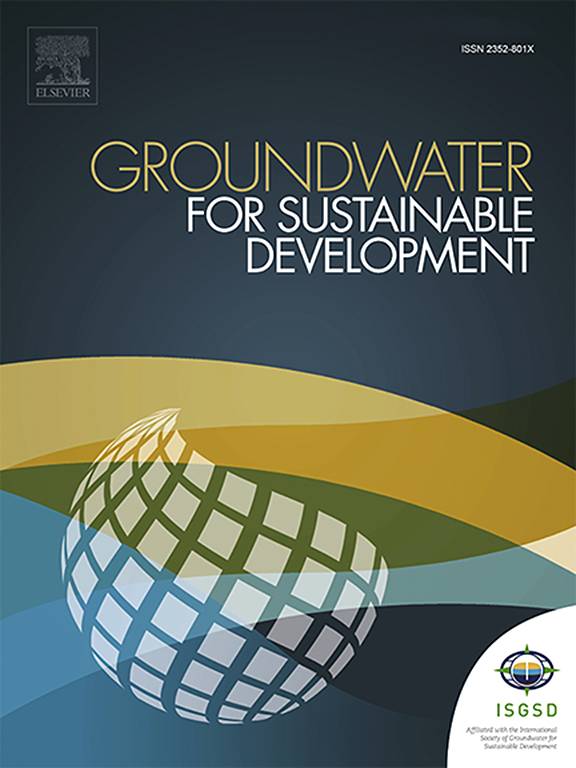Origin and processes of groundwater salinity hotspots in the irrigated Sahara Desert lands of Egypt
IF 4.9
Q2 ENGINEERING, ENVIRONMENTAL
引用次数: 0
Abstract
Groundwater salinity hotspots in shallow aquifers have been reported across various geographical and climatic settings. These hotspots are commonly linked to anthropogenic influences, particularly irrigation return flow, in arid, unconfined aquifers under intensive irrigation. However, the interplay of geological and hydrochemical processes in shaping salinity variation and hotspots formation remains insufficiently understood. This study integrates hydrochemical, isotopic, multivariate statistical, and geophysical methods to better understand the regional distribution and origin of groundwater hotspots in the newly reclaimed areas of the Eastern Sahara, along the desert fringes of the Nile River. The findings suggest that salinization in the aquifer is influenced by evaporite dissolution, silicate weathering, salts leaching, ion exchange, and groundwater mixing processes, with significant anthropogenic contributions from irrigation return flow and fertilizer application. Notably, we report for the first time that salt-rich marine clay layers, which were left unflushed during the evolution of the Nile River, serve as the primary source of salinity hotspots. These clay layers act as natural barriers, restricting groundwater exchange with the Quaternary Nile aquifer while promoting salinization through saline/formation water upconing due to excessive groundwater pumping. Furthermore, inefficient irrigation practices add more water through irrigation return flow to the sandy alluvium aquifer, which exacerbates the groundwater salinity and ultimately leads to the development of waterlogged areas. These findings highlight the significant impact of river system evolution dynamics on groundwater quality and call for revisiting the current irrigation strategies in the newly reclaimed areas along the Nile River's desert fringes.

埃及撒哈拉沙漠灌溉地区地下水盐度热点的起源和过程
在不同的地理和气候环境下,已经报道了浅层含水层的地下水盐度热点。这些热点通常与人为影响有关,特别是在密集灌溉的干旱无承压含水层的灌溉回流。然而,地质和水化学过程在形成盐度变化和热点形成中的相互作用仍未得到充分了解。本研究综合了水化学、同位素、多元统计和地球物理方法,以更好地了解尼罗河沿岸新开垦的东撒哈拉地区地下水热点的区域分布和起源。研究结果表明,含水层的盐渍化受蒸发岩溶解、硅酸盐风化、盐类淋滤、离子交换和地下水混合过程的影响,灌溉回流和施肥对盐渍化有重要的人为贡献。值得注意的是,我们首次报道了在尼罗河演化过程中未被冲刷的富盐海洋粘土层是盐度热点的主要来源。这些粘土层起到天然屏障的作用,限制了地下水与第四纪尼罗河含水层的交换,同时由于过度抽取地下水,导致咸水/地层水上升,从而促进了盐碱化。此外,低效的灌溉方式使更多的水通过灌溉返流流入砂质冲积层含水层,从而加剧了地下水的盐度,最终导致涝渍地区的发展。这些发现强调了河流系统演化动态对地下水质量的重大影响,并呼吁重新审视尼罗河沙漠边缘新开垦地区目前的灌溉策略。
本文章由计算机程序翻译,如有差异,请以英文原文为准。
求助全文
约1分钟内获得全文
求助全文
来源期刊

Groundwater for Sustainable Development
Social Sciences-Geography, Planning and Development
CiteScore
11.50
自引率
10.20%
发文量
152
期刊介绍:
Groundwater for Sustainable Development is directed to different stakeholders and professionals, including government and non-governmental organizations, international funding agencies, universities, public water institutions, public health and other public/private sector professionals, and other relevant institutions. It is aimed at professionals, academics and students in the fields of disciplines such as: groundwater and its connection to surface hydrology and environment, soil sciences, engineering, ecology, microbiology, atmospheric sciences, analytical chemistry, hydro-engineering, water technology, environmental ethics, economics, public health, policy, as well as social sciences, legal disciplines, or any other area connected with water issues. The objectives of this journal are to facilitate: • The improvement of effective and sustainable management of water resources across the globe. • The improvement of human access to groundwater resources in adequate quantity and good quality. • The meeting of the increasing demand for drinking and irrigation water needed for food security to contribute to a social and economically sound human development. • The creation of a global inter- and multidisciplinary platform and forum to improve our understanding of groundwater resources and to advocate their effective and sustainable management and protection against contamination. • Interdisciplinary information exchange and to stimulate scientific research in the fields of groundwater related sciences and social and health sciences required to achieve the United Nations Millennium Development Goals for sustainable development.
 求助内容:
求助内容: 应助结果提醒方式:
应助结果提醒方式:


